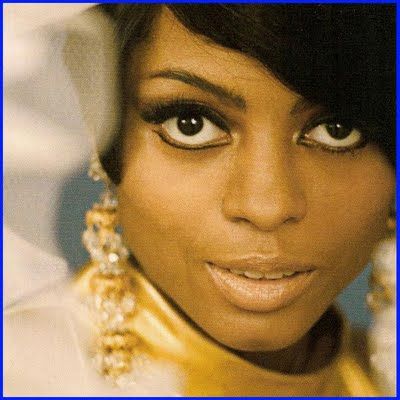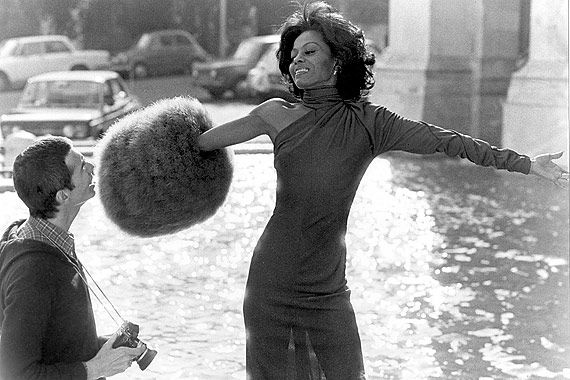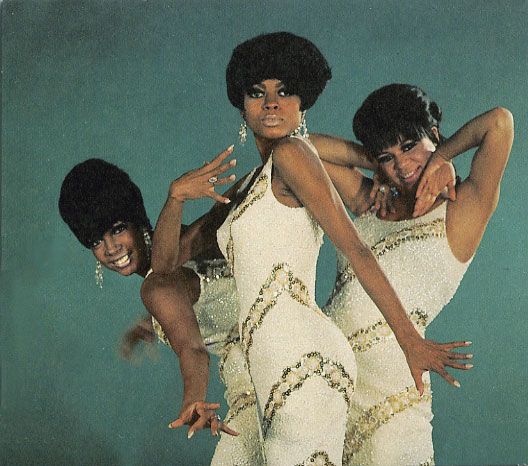Stop! In the Name of Love
After being picked up by the burgeoning label and hitting the road, there was no stopping Diana Ross. “The Supremes became a phenomenon,” she says. “We became example of what was possible for young girls growing up.” What an understatement. Oprah Winfrey once recounted that she had wanted to grow up to be like Diana Ross ever since she first tuned in to see them on “The Ed Sullivan Show” in 1964. Ross knows inspiration first-hand. “My mentors were the women in my family who guided me and demonstrated the importance of personal sacrifice, hard work, perseverance and unconditional love,” Ross reveals. “Never underestimate the power of love and mentorship.”
For Winfrey, like so many others, that pivotal appearance of talented and beautiful young black women appearing in the public arena for the first time was like a shot heard ‘round the world. After an initial stall, with eight record releases that went nowhere since the group first formed in 1961, the Supremes scored their first Number One hit with “Where Did Our Love Go” the same year of their Sullivan show debut. Then, almost every song they released thereafter rapidly found its way to Number One on the Billboard pop charts. With 12 Number Ones and a whopping 18 Top Ten hits for the group, America fell supremely under the group’s spell. Supremes-inspired clothing, paper dolls, lunchboxes and an array of other merchandise followed. The world, it appeared, was their tune-filled oyster.
Songs like “Baby Love,” “I Hear a Symphony” and “Back in My Arms Again,” along with the colossal hits of the Four Tops, The Miracles, The Temptations and myriad other hit-making performers were courtesy of the newly formed Motown label. All the groups were optimistic and captured the spirit of change. Berry Gordy, the label’s founder, would call the company the Sound of Young America. Gordy made sure each group inspired not only its fans, but also onlookers across the world with his savvy control over how the acts looked, danced and performed in public. Their polished appearance was hard work that paid off—especially for the Supremes. Gowns of satin, sequins, fur and feathers—some designed by Bob Mackie—were never too elaborate. Concerts, television appearances and fan magazines following their every move proved that America bought what the Supremes and Motown was selling: glamour, glitz, soul and the high life.
Ain’t No Mountain High Enough Like many fairytales, a happy story can sometimes run its course. By the late 1960s, the hectic performance schedules, appearances and personality conflicts took their toll on the group and those around them. “Sometimes it becomes so redundant retelling the Supremes story but I realize how important the story is and how people really are interested,” says Mary Wilson, one of the original Supremes, in another interview. The third Supreme, Florence Ballard, left the group in 1967. “Obviously, when Florence had to leave the group and was replaced by Cindy Birdwell, I was very saddened,” recalls Wilson. “This, for me, meant the end of the Supremes. Cindy is a beautiful human being, inside and out; however, for me, without the three original girls, the dream was over.”
On November 8, 1969, Gordy announced that Ross was leaving the Supremes in order to pursue a solo career, so their final concert with Ross was played on January 14, 1970, at the Frontier Hotel in Las Vegas, Nevada. Their last hit, ironically, was titled “Someday We’ll Be Together.” While the group carried on for a few more years in other incarnations, Ross pressed forward with her solo career. Even though the Supremes’ personal and professional journey was distorted first in the Broadway play “Dreamgirls,” then in the smash hit film version, there are striking similarities, though most insiders deny any actual resemblance. Ross, in other interviews, has claimed to have never seen “Dreamgirls.”
Of course, there is no denying that the Supremes’ success laid the foundation for Diana Ross’ road to further superstardom. “Becoming a solo artist required a commitment and an intention to create a new direction,” Ross confides. “It was time to listen to my heart and move forward to a positive future. I felt that it was my time to take control of my own destiny. And, that is not always easy.” Her solo career, in which Motown heavily invested, continued to skyrocket with her first two releases, “Ain’t No Mountain High Enough” and “Reach Out and Touch (Somebody's Hand)”—both catapulting to Number One on the charts.
Reach Out and Touch
Balancing life with concert appearances, in 1971, Ross found time to marry Robert Silberstein, a pop-music manager with whom she had three daughters, Rhonda, Tracee and Chudney. After remarrying Norwegian financier Arne Naess, Jr. in 1985, Ross had two sons, Evan and Ross Arne Naess. “Being a mother means everything to me. Everything. My children are my life,” Ross shares. “There are a lot of difficulties in being a celebrity and trying to raise children. I feel like I am a private person in a public life. Raising five children requires keeping your priorities and values in the right place.” In between it all, as if a superstar recording career and a bustling family was not enough, Hollywood called with opportunity, and Diana Ross took that call.
“Being an actress and making a film was a new experience for me, but only difficult because it was different,” says Ross. “I had to find my own method of study, my own way of researching and preparation.” Like singing, Ross never took an acting lesson. “The commitment is key,” she offers. “I think one important ingredient was that I always listened. Being an actress requires knowing your instrument very well, as if you’re playing a violin. To be an actress there are two words: commitment and discipline. That got me a nomination for an Academy Award™,” she reveals.
While Ross’ lithe songbird voice is world renowned, the films also firmly entrenched Diana Ross as a pop icon. The golden guy nomination came for 1972’s massive hit film “Lady Sings the Blues,” about the drug-addicted, yet talented singer, Billie Holiday, in which Ross co-starred with 1970s heartthrob Billy Dee Williams. She followed up that taxing role’s success with “Mahogany,” a 1975 art-imitates-life film about a poor girl from the Projects who finds fame and fortune—this time in the fashion industry instead of onstage. The movie confirmed Ross as a high fashion icon and also solidified the Yves Saint Laurent and Halston-inspired fashion sense of the 1970s for the movie-going public. The film’s Oscar™-nominated song, “Do You Know Where You’re Going To?” added more fuel to her film career’s widespread fire. In 1976, Ross was even cast to play Dorothy in the film version of the successful Broadway play, “The Wiz.”
It’s My Turn
After stepping back from the movies, Ross recreated herself yet again in the mid 1970s as a disco dance diva. “Love Hangover” and other hits from the wildly successful album, The Boss, which included such hits as the song’s title track, “I’m Coming Out and “Upside Down” became the anthems of the “Me” Decade. Ross sang about fun and freedom, and all her fans responded to her in droves. As the 1980s began, she sang theme songs to the eponymous hit movies, “Endless Love” and “It’s My Turn.” The concert and talk show appearances and the television specials were non-stop. Hit releases like “Mirror, Mirror,” “Missing You,” “Why Do Fools Fall in Love?” “Swept Away” and a plethora of albums would keep Ross in the limelight through the 1980s and well into 1990s.
No matter the diva stories one might hear, Ross’ theory was that the more she “reached out and touched,” the better the world might be. She learned well from her mentors. “I got the chance to sing with Marvin Gaye, The Temptations, Ray Charles and Stevie Wonder,” Ross recounts. “I have always been able to learn what to do and what not to do from these talented artists,” Ross recounts. She certainly worked her own mentoring magic on the Jackson brothers. Most don’t know that Diana Ross was integral to the Jackson Five’s singing success. The Jackson Five was the group of brothers that moved Motown’s Berry Gordy to famously term their music as soul bubblegum.
Just how did she apply her experience to help guide the famed five? “First, you come up with the concept of what you want to sing about, and then you either write the songs or you find songwriters to assist you with those ideas,” she explains. “Nothing is ever done alone. It always requires collaboration with producers, musicians, engineers, recording studios, graphic artists and video editors and directors. It is never just you who comes up with any creative work, so this is where you really have to think about your goals and aspirations.”
Reflections
Over the course of the Brilliant Lecture Series, Ross has been as revealing as a star gets, constantly enthralling and encouraging her audience. “Image is very important—it’s about how you present yourself,” she asserts. “Bur, inner beauty is more important to me than outer beauty. Being beautiful has become a business. There are those who judge you for how you look, as beauty has become a competition. To me, good health, dignity, aging and wisdom radiates as beauty.” One fact remains—there is no disputing the inherent beauty of Ross’s illustrious singing voice. Her latest album, I Love You, released in 2007, pays homage to classic love songs, handpicked by Ross. The lady still has what it takes and there are no signs of compromise in her soaring voice.
After almost five decades of superstardom, the effects of Diana Ross and the Supremes live on in our fond memories and on our iPods. In May, Mary Wilson’s costumes from the trio went on display at the Victoria and Albert Museum in London, and it will likely draw sell-out crowds until the exhibit leaves in October when it heads to the Rock and Roll Hall of Fame in Cleveland. And, Ross is candid as always about her future. “At this time in my career I have a desire to contribute in other ways, maybe directing or producing; unless the right film opportunity presents itself, I probably will not be in another film,” she asserts. Still optimistic about the other facets of her world, Ross puts her life in perspective, offering, “I am living my dream. My career has never been about making money or being famous—I just wanted to sing, be a writer and a performer. Dreams really do come true.”
Diana Ross points out what means the most to her and her continued success. “Here is a list filled with some of the lessons that I have learned on my quest to make a difference,” she says.
It’s important to define what matters most. What do you want? What do you need?
Ask the right questions and continue to change those questions.
Ask why. Ask why not.
Have the courage to act.
Use your imagination.
Take the chance.
Write out your goals and aspirations.
Be persistent.
Assign deadlines.
Pause a bit.
Expect the unexpected.
Expect resistance.
Listen to the heart. Opportunity knocks softly.
Schedule peaceful thinking time.
Schedule deliberate thinking time.
Schedule recreation time.
Schedule prayer time.
Give yourself a pat on the back.
Check your timing and discipline.
Coexist with the unresolved.



